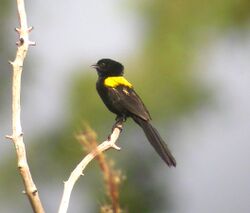Biology:Yellow-mantled widowbird
| Yellow-mantled widowbird | |
|---|---|

| |
| Nominate race in the Central African Republic | |
| Scientific classification | |
| Domain: | Eukaryota |
| Kingdom: | Animalia |
| Phylum: | Chordata |
| Class: | Aves |
| Order: | Passeriformes |
| Family: | Ploceidae |
| Genus: | Euplectes |
| Species: | E. macroura
|
| Binomial name | |
| Euplectes macroura (Gmelin, JF, 1789)
| |
The yellow-mantled widowbird (Euplectes macroura), also known as the yellow-backed widow, is a species of bird in the family Ploceidae.
Taxonomy
The yellow-mantled widowbird was formally described in 1789 by the German naturalist Johann Friedrich Gmelin in his revised and expanded edition of Carl Linnaeus's Systema Naturae. He placed it with the crossbills in the genus Loxia and coined the binomial name Loxia macroura. Gmelin specified the locality as "Whydah"; this is Ouidah on the coast of Benin is East Africa.[2] The specific epithet is from Ancient Greek makros meaning "long" and -ouros meaning "tailed".[3] The yellow-mantled widowbird is now one of 18 species placed in the genus Euplectes that was introduced in 1829 by the English naturalist William John Swainson.[4]
- E. m. macrocercus (Lichtenstein, MHC, 1823) – Ethiopia, Uganda and west Kenya
- E. m. macroura (Gmelin, JF, 1789) – Senegal and Gambia to south Sudan and southwest Kenya and south to Zambia, Malawi, Zimbabwe and west Mozambique
- E. m. conradsi (Berger, 1908) – Ukerewe Island in Lake Victoria
Description
Males are larger than females and acquire longer tails and striking black and golden yellow plumages in the breeding season. The mantle colour is either golden yellow, or in the case of the northeastern race, E. m. macrocercus, black. The yellow shoulders persist in all male plumages, whether breeding or non-breeding.[5]
Range and habitat
Its natural habitat is subtropical or tropical seasonally wet or flooded lowland grassland. It is widely distributed in Africa, and is found in Angola, Benin, Burkina Faso, Burundi, Cameroon, Central African Republic, Chad, Republic of the Congo, Democratic Republic of the Congo, Ivory Coast, Gabon, Gambia, Ghana, Guinea, Guinea-Bissau, Liberia, Malawi, Mali, Mozambique, Niger, Nigeria, Senegal, Sierra Leone, Sudan, Tanzania, Togo, Zambia and Zimbabwe. The distinctive race E. m. subsp. macrocercus occurs in Eritrea, Ethiopia, western Kenya and Uganda.[5]
References
- ↑ BirdLife International (2016). "Euplectes macroura". IUCN Red List of Threatened Species 2016: e.T22719209A94617791. doi:10.2305/IUCN.UK.2016-3.RLTS.T22719209A94617791.en. https://www.iucnredlist.org/species/22719209/94617791. Retrieved 12 November 2021.
- ↑ Gmelin, Johann Friedrich (1789) (in Latin). Systema naturae per regna tria naturae : secundum classes, ordines, genera, species, cum characteribus, differentiis, synonymis, locis. 1, Part 2 (13th ed.). Lipsiae [Leipzig]: Georg. Emanuel. Beer. p. 845. https://www.biodiversitylibrary.org/page/2656340.
- ↑ Jobling, James A. (2010). The Helm Dictionary of Scientific Bird Names. London: Christopher Helm. p. 236. ISBN 978-1-4081-2501-4.
- ↑ Gill, Frank; Donsker, David; Rasmussen, Pamela, eds (July 2023). "Old World sparrows, snowfinches, weavers". IOC World Bird List Version 13.2. International Ornithologists' Union. https://www.worldbirdnames.org/bow/weavers/.
- ↑ 5.0 5.1 Sinclair, I. & Ryan P. (2010). Birds of African south of the Sahara. Cape Town: Struik Nature. ISBN 978-1-77007-623-5.
External links
- (Yellow-mantled widowbird = ) Yellow-backed widow - Species text in The Atlas of Southern African Birds
Wikidata ☰ Q1305633 entry
 |



